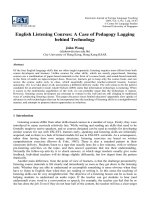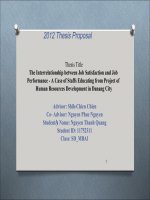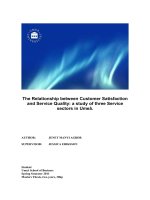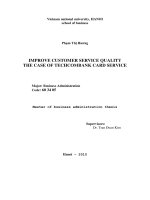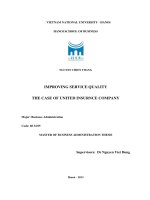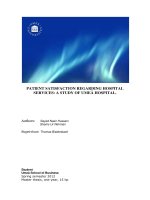Students satisfaction towards service quality a case of hochiminh city university of technical education
Bạn đang xem bản rút gọn của tài liệu. Xem và tải ngay bản đầy đủ của tài liệu tại đây (2.36 MB, 162 trang )
STUDENTS’ SATISFACTION TOWARDS SERVICE QUALITY:
A CASE OF HOCHIMINH CITY UNIVERSITY
OF TECHNICAL EDUCATION
In Partial Fulfillment of the Requirements of the Degree of
MASTER OF BUSINESS ADMINISTRATION
In International Business
By
Mrs. Vo Thi Khanh Van
ID: MBA03040
International University - Vietnam National University HCMC
March 2013
STUDENTS’ SATISFACTION TOWARDS SERVICE QUALITY:
A CASE OF HOCHIMINH CITY UNIVERSITY
OF TECHNICAL EDUCATION
In Partial Fulfillment of the Requirements of the Degree of
MASTER OF BUSINESS ADMINISTRATION
In International Business
by
Mrs. Vo Thi Khanh Van
ID: MBA 03040
International University - Vietnam National University HCMC
March 2013
Under the guidance and approval of the committee, and approved by all its members,
this thesis has been accepted in partial fulfillment of the requirements for the degree.
Approved:
----------------------------------------------
Chairperson
----------------------------------------------
Committee member
----------------------------------------------
Committee member
---------------------------------------------
Committee member
---------------------------------------------
Committee member
---------------------------------------------
Committee member
Acknowledgement
I would like to express my heartfelt gratitude and deepest appreciation to my
Supervisor, Dr. Luu Trong Tuan for his patient and intensive support to provide
guidelines, valuable suggestions, challenging ideas and encouragement, reading and
commenting on this thesis.
Secondly, I would like to send my sincere thanks to Dr. Nguyen Quynh Mai, Dr. Mai
Ngoc Khuong, Dr. Pham Hong Hoa – members of the proposal examination
committee, for their valuable comments and suggestions.
Thirdly, I would like to express my thanks to the management team and students at
HoChiMinh City University of technical education for their great support me by giving
the constructive opinion with special sources of information and data collection. I offer
my great thanks to all my teachers at the Business Administration Faculty of
International University for their teaching and guiding me during my MBA course.
Lastly, I heartily thank my families, my friends, and those who supported during my
working on the thesis.
-i-
Plagiarism Statements
I would like to declare that, apart from the acknowledged references, this thesis either
does not use language, ideas, or other original material from anyone; or has not been
previously submitted to any other educational and research programs or institutions. I
fully understand that any writings in this thesis contradicted to the above statement
will automatically lead to the rejection from the MBA program at the International
University – Vietnam National University Hochiminh City.
- ii -
Copyright Statement
This copy of the thesis has been supplied on condition that anyone who consults it is
understood to recognize that its copyright rests with its author and that no quotation
from the thesis and no information derived from it may be published without the
author‟s prior consent.
© Vo Thi Khanh Van/MBA 03040/2013
- iii -
Table of Contents
Acknowledgement.........................................................................................................i
Plagiarism Statements .................................................................................................ii
Copyright Statement ................................................................................................. iii
List of Figures ............................................................................................................. vi
List of tables ...............................................................................................................vii
Abstract ....................................................................................................................... ix
Chapter 1: INTRODUCTION .................................................................................... 1
1.1 Research Background ........................................................................................... 1
1.2 Research Problems ............................................................................................... 4
1.3 Research objectives and research questions ......................................................... 7
1.4 Overview of HCMCUTE ..................................................................................... 7
1.4.1 Name of the University .................................................................................. 7
1.4.2 Brief History of HoChiMinh City University of Technical Education ........... 8
1.4.3 Function, Mission, Objectives, and Quality policy ........................................ 8
1.4.4 Functional Departments and Organizational Chart and of HCMCUTE ....... 11
1.5 Structure of the thesis ......................................................................................... 13
Chapter 2: LITERATURE REVIEW ...................................................................... 15
2.1 Satisfaction ......................................................................................................... 15
2.1.1 Customer satisfaction ................................................................................... 15
2.1.2 Student satisfaction ...................................................................................... 16
2.2 Service quality .................................................................................................... 17
2.2.1 Definitions of Service quality ...................................................................... 17
2.2.2 Components of Service quality .................................................................... 19
2.2.3 Service quality in education ......................................................................... 23
2.3 Service quality and student satisfaction .............................................................. 26
2.4 Service quality model ......................................................................................... 28
2.4.1 Service quality model of Parasuraman ......................................................... 28
2.4.2 Educational service quality model ............................................................... 36
Chapter 3: RESEARCH METHODOLOGY .......................................................... 41
3.1 Research design .................................................................................................. 41
3.2 Research approaches .......................................................................................... 42
- iv -
3.2.1 Qualitative approaches ................................................................................. 42
3.2.2 Quantitative approaches ............................................................................... 43
3.3 Sampling ............................................................................................................ 44
3.3.1 Population .................................................................................................... 44
3.3.2 Sample size .................................................................................................. 44
3.4 Data collection ................................................................................................... 46
3.4.1 Secondary data ............................................................................................. 46
3.4.2 Primary data ................................................................................................. 47
3.4.3 Measurement scale ....................................................................................... 53
3.5 Data analysis ...................................................................................................... 55
3.5.1 Descriptive Statistics .................................................................................... 55
3.5.2 Reliability Statistics ..................................................................................... 55
3.5.3 Exploratory Factor Analysis......................................................................... 55
Chapter 4: DATA ANALYSIS ................................................................................. 57
4.1 Demographic ...................................................................................................... 57
4.2 Descriptive statistics ........................................................................................... 59
4.2.1 Expectation scores........................................................................................ 59
4.2.2 Perception Scores ......................................................................................... 62
4.3 Scale Analysis .................................................................................................... 64
Chapter 5: DISCUSSION AND FINDINGS ............................................................ 76
5.1 Service quality assessment ................................................................................. 76
5.2 Information on students‟ expectations ................................................................ 87
5.3 Information on students‟ perception ................................................................... 90
5.4 Information of the gap scores ............................................................................. 92
5.5 Information on students‟ comments ................................................................... 95
Chapter 6: IMPLICATIONS, RECOMMENDATIONS, LIMITATIONS AND
CONCLUSIONS ...................................................................................................... 102
6.1 Implications of this research ............................................................................. 102
6.2 Recommendations for HCMCUTE .................................................................. 105
6.3 Limitations of the study .................................................................................... 113
6.4 Conclusions ...................................................................................................... 114
REFERENCES ........................................................................................................ 117
-v-
List of Figures
Figure 1.1: Service
quality
Report
from Academic
affair department ..... 5
Figure 1.2: Organizational chart of HCMCUTE ......................................................12
Figure 2.1: Gap Model of Parasuraman ...................................................................29
Figure 2.2: EduQAL Model of Khan .......................................................................40
Figure 3.1: Research process ...................................................................................42
Figure 3.2: Semi-structure Interview Experts at HCMCUTE ..................................48
Figure 4.1: Demographic information .....................................................................58
Figure 4.2: Information of Faculty...........................................................................59
Figure 5.1: Dimension gap score of service quality at HCMCUTE .........................79
Figure 5.2: Learning outcomes dimension ...............................................................79
Figure 5.3: Physical facility dimension....................................................................81
Figure 5.4: Academic dimension .............................................................................82
Figure 5.5: Responsiveness dimension ....................................................................84
Figure 5.6: Social integration dimension .................................................................86
Figure 5.7: The highest expectation .........................................................................87
Figure 5.8: The lowest Expectation .........................................................................88
Figure 5.9: The highest perception ..........................................................................90
Figure 5.10: The lowest perception .........................................................................91
Figure 5.11: The highest gaps ..................................................................................93
Figure 5.12: The lowest gaps ...................................................................................94
Figure 6.1: Components.........................................................................................113
- vi -
List of Tables
Table 2.1: Previous studies towards service quality and student satisfaction ..........39
Table 4.1: Expectation scores ..................................................................................59
Table 4.2: Perception scores ....................................................................................62
Table 4.3: Cronbach‟s alpha of expected Learning Outcomes dimension ...............65
Table 4.4: Cronbach‟s alpha of expected Physical Facility dimension ....................66
Table 4.5: Cronbach‟s alpha of expected Academic dimension ..............................66
Table 4.6: Cronbach‟s alpha of expected Responsiveness dimension......................66
Table 4.7: Cronbach‟s alpha of expected Personality Development dimension.......67
Table 4.8: Cronbach‟s alpha of perceived Learning outcomes dimension ...............67
Table 4.9: Cronbach‟s alpha of perceived Physical facility dimension ....................67
Table 4.10: Cronbach‟s alpha of perceived Academic dimension ...........................68
Table 4.11: Cronbach‟s alpha of perceived Responsiveness dimension ..................68
Table 4.12: Cronbach‟s alpha of perceived Personality development dimension ....68
Table 4.13: Cronbach‟s alpha of perceived Personality development dimension
without PERSO38....................................................................................................70
Table 4.14: KMO and Bartlett‟s Test for Independent Variables ............................70
Table 4.15: Total variance explained .......................................................................70
Table 4.16: Pattern Matrixa .....................................................................................71
Table 4.17: Factor 1 .................................................................................................72
Table 4.18: Factor 2 .................................................................................................72
Table 4.19: Factor 3 .................................................................................................73
Table 4.20: Factor 4 .................................................................................................73
Table 4.21: Factor 5 .................................................................................................74
Table 4.22: Reliability Testing by Cronbach‟s alpha ...............................................74
Table 5.1: Perceptions score-Expectation score-Gap score......................................78
- vii -
List of Appendix
Appendix 1: Survey questionnaire .........................................................................122
Appendix 3.1: Sources for questionnaire development: dimension of EduQUAL Model
...............................................................................................................................125
Appendix 3.2: Initial questionnaire from Literature Review .................................126
Appendix 3.3: Final version of the questionnaire ..................................................126
Appendix 3.4: Coded measurement scale ..............................................................129
Appendix 4: ...........................................................................................................132
- viii -
Abstract
In education, quality is all about systems that lead to good academic culture, excellent
academic results, progressive and adaptive management, clean administration and
prominent profile of outgoing students. Thanks to that, service quality in education has
become one of the most major issues in worldwide. Nowadays, improving educational
service quality is the most important task of any Universities not only in Vietnam but
in the world as well. The research aims to analyze students‟ satisfaction on educational
service quality in HoChiMinh City University of Technical Education (HCMCUTE).
The study uses the EduQUAL instrument of
Khan (2007)
based on
SERVQUAL model of Parasuraman (1985,1988) which was adapted for Vietnamese
educational context, to find out the gaps within student‟ attitudes regarding to
perceived and expected quality. The EduQUAL instrument was proved to have high
relationship between reliability and validity. This study was conducted from October
2012 to March 2013 at HCMCUTE.
In this study, the respondents were the fourth year students in six technical
engineering of Faculties with the sample size of 288. SPSS software 20.0 was used to
analyze the collected data. The data was analyzed in four steps: Descriptive Statistic,
Reliability test, Exploratory Factor Analysis and Gap Score Analysis with a part of
students‟ comments.
The results showed that the most important dimension in measuring student‟s
satisfaction on service quality at HCMCUTE was Physical facilities concerning to
workshops, laboratories, classrooms condition, studying and learning material
resources, etc. The next important dimension was Responsiveness with students‟
comments related to staff attitude at service departments and administrative
procedures. Learning outcomes was also important dimension since it was the ability
to provide the promised service dependently and accurately for students after they
graduated. Academic dimension was less impact on students‟ satisfaction but it
showed that the management team of HCMCUTE should improve more about this
dimension. The lowest impact was Social integration.
Keywords: Service Quality; Students‟ satisfaction; students‟ perception; students‟
expectation; Gap score; HCMCUTE.
- ix -
-x-
Chapter 1
INTRODUCTION
This chapter makes a general introduction about research background, rationale and
research problem, as well as research objectives.
1.1 Research Background
Globalization has brought several changes in many spheres of human life. Due to
globalization, both products and service markets, “in and outside” the country has
become highly competitive. Educational reforms have been taking place in a number
of countries since the early 1970s (Ginsberg, 1991; Lawson 1992). Different reasons
have been given to explain educational changes, but according to Gordon (1992) the
main themes used by various nations involved in this process are the issues of
accountability, efficiency, managerially, and the arrival of monetarist economic
policies which advocate the commoditization of education. Nowadays, education is a
service directly impacted on by the provider. Higher education institutions are placing
greater emphasis on meeting students‟ expectations and needs. As universities
continue to become more students oriented, student perceptions of higher educational
facilities and services are becoming more important (Anci, D.T., 2006).
Educational service quality is one of the most important things whenever we mention
about Education. There are many definitions about quality in which relationship is
mentioned as a link between quality and customer‟s need and satisfaction. Christou
and Sigala (2002) stated satisfaction is based on customer‟s expectation and perception
of service quality. According to Tapiero (1996), the term “quality” depends on the
person making the definition, the measures applied and the context within which it is
-1-
concerned. Pariseau and McDaniel (1997) defined “Quality is excellence”, “Quality is
value”, “Quality as exceptional” (Parri 2006, Horsburgh 1998), this concept is often
connected to two examples about the exception of Cambridge and Oxford University.
In this situation, “Quality” is considered as an obvious manner and people do not need to
check or assess. In an educational Institute, quality is understood as fitness for purpose
concerning to input and output. Related to survey from Oxford University in the year
2009, 81% students satisfied with the quality courses and 70% students satisfied with the
facilities, library resources, IT equipment and services provided by the University.
Especially, quality of lecturers and staffs was highly assessed, 83% students found that the
lecturers were always or usually good at explaining things which suggest that students feel
they are receiving a good quality education and nearly all staffs at Oxford University are
friendly, supportive, helpful and enthusiastic.
In Vietnam, educational system, especially higher education, with the main
purpose to train and adapt high quality labor force to the society, is not out of this trend.
Currently, Vietnamese Universities need to bring in to play internal force strongly to
obtain successfully vision and mission. In order to exist and survey in modern technology,
service quality should be more mentioned. Basing on the central resolution on April 15 th,
2009 about education and training development to the year 2020 in Vietnam, there are
some factors need to be highlighted that educational institutes have to innovate and train
framework and complete higher education system; to innovate teaching programs, method
and training process; to innovate project duty, training, improving and employing
managers; and to innovate in organizing and developing scientific technology.
Athiyainan and O‟Donnel (1994) stated that higher education institute seeking to
assess quality must firstly identify the institutional characteristics that are most valued
-2-
by its clients and then measure the clients‟ perception of the institution performance
against these characteristic.
Nowadays, most of educational institutions both private and state organization also
care so much about the service quality to attract the learners. They always try to listen
what the learners expect and perceive. Parasuraman et al. (1985) developed the gap model
of service quality and proposed an instrument to measure service quality, besides that
service quality is more difficult to be measured than goods quality. This raises the issue
of “who is the customer in education”. In educational institute, there are many
stakeholders such as students, lecturers, staff, alumni, department, faculty, donors,
sponsors, etc. Chua (2004) defined people perceive quality differently. It is true that in
order to improve the quality service to satisfy customers, we have to understand clearly
what those customers need.
Being one of the members of the World Trade Organization (WTO), Vietnamese
Education gets a big opportunity for all people. Educational service quality is daily
increasing, there are a lot of foreign Institutes invested to Vietnam and that causes a
strict competition among foreign and local Universities related to service quality to
attract the learners. The challenge is that students will get a higher level in teaching
and learning. The learners must try their best to get acquainted with new teaching
methodology. The lecturers must improve their knowledge to catch up with modern
and international training programs. The staffs also improve their service quality to
satisfy the all participants who enjoy in the operation of the Institute. The last but not
least, the educational Institutes have to invest in facilities, library sources, fresh
environment, IT equipment, etc. Final result is that educational quality will be greatly
upgraded.
-3-
HCMCUTE now is fifty years old, half of century and widely well known as
one of the leading technical education University in the south of Vietnam, an
experienced and dynamic state-run University, offers quality technology-oriented
training programs in a supportive and student-caring environment.
1.2 Research Problems
HCMCUTE has well-recognized that educational service quality plays an important part
in developing of organization as well as the most competitive advantage in society. Thus,
the University strive to become one of the top ten multi-disciplinary Universities in
Vietnam and for the objectives in period up to 2015 are: to increase the total number of
academic staff to 940, of whom over 85% should have postgraduate qualifications; to
upgrade existing infrastructures and material facilities and equip new ones to guarantee
the delivery of quality training to 30,000 students. Training programs should be highly
adaptable to the labor market. Qualifications should be widely recognized in both the
region and the world. In the long run, strive to become one of the top ten multidisciplinary universities in Vietnam. HCMCUTE‟ activities should exert a positively
influence on the spiritual and material life of the society, especially in HoChiMinh City
and the southern provinces.
Currently, quality is still a new concept to those working in education service,
especially in HCMCUTE, a state University. The research aims to conduct an
assessment about students‟ satisfaction on educational service quality at HCMCUTE.
Basing on the outcome of this research, the manager will see a whole picture about
educational service quality effect on students at the University and according to the
findings, there should be some helpful and meaningful recommendations to the board
of manager. However, together with the developing of such famous local and foreign
-4-
educational institutions in Vietnam, HCMCUTE has to pay attention to the educational
service quality to attract more students.
Being a leading technical education University, HCMCUTE ought to provide
competent trainers directly responsible for training and upgrading qualified manpower
for the process of modernization and industrialization of the country and build up a
knowledge-based economy.
First, academic curriculum must be carefully considered. Curriculum design should be
suitable with the learners and interact with the demand of employer, especially learning
outcomes should be applied positively and sufficiently to fulfill all skills to students
before they go out to the society. In order to implement the above objectives, the
University needs more high quality lecturers who have local and oversea study at
prestigious institutions. Being a technical education, well equipped laboratories with
modern facilities can‟t be lack. Students should be studied in a fresh environment with full
services. The last but not least, the staff play an important role in service quality they need
more active, helpful and be ready to satisfy students‟ requirement.
Basing on statistic report and students information comments from Student Affair
Department on March 2012, there are some statements related to service quality at
HCMCUTE as shown in Figure 1.1.
Figure 1.1
Service quality Report from Academic Affair Department March 2012
-5-
This statistic report was conducted basing on graduates students who completed the
program by December 2011 and came back to the University on March 2012 to get
degree with 1,074 students. Among them, there are 21.90% students who pay attention
to soft skills training during the time they study at the university. There is 23.18%
students take part in recruitment affair at the University and get the job through this
channel. 38.18% student stated that teaching method at the campus so far acceptable
and the University also cares about arranging teaching consultants to students with
23.93%. According to students comments related to some service departments, the
students do not satisfy with service attitude of the staff, one student in the fourth year
of Electrical Electronic Engineering Faculty states in front of the meeting among
managers and students that “I am disappointed with the service attitude of some
service Department, especially Student Affair Department, the lady who sits beside the
door shouts us strongly when we make something wrong with the procedure for
scholarship application, this is not a good behavior in educational environment”.
Setting up prestige and brand name is the most important for any organization,
especially in education since students are the main products and the society will look
at these products to assess how successful the University is. Realizing the importance
of students‟ satisfaction in educational service quality in recent years and some above
evidence related to students‟ satisfaction, HCMCUTE have conducted several
researches related to students‟ satisfaction with training qualification, learning
outcomes, assessment companies‟ satisfaction about UTE graduates, etc. and the study
also supports for this purpose.
-6-
1.3 Research objectives and research questions
The research objectives will be set up basing on following points:
-
To identify which factors affect educational service quality at HCMCUTE.
-
To exmine the difference between students‟ perceptions and students‟
expectations towards factors of educational service quality.
-
To provide recommendations to top management team regarding these factors
of educational service quality for increasing students‟ satisfaction related to
educational service quality at HCMCUTE.
The research questions will be set up as follow:
-
What are the factors affecting educational service quality at HCMCUTE?
-
What are the difference between students‟ perceptions and expectation towards
factors of educational service quality?
-
What are recommendations to top management team regarding to these factors
of educational service quality for increasing students‟ satisfaction related to
educational service quality at HCMCUTE?
1.4 Overview of HCMCUTE
1.4.1 Name of the University
Logo:
Vietnamese name: Trường Đại học Sư phạm kỹ thuật Thành phố Hồ Chí Minh
English name:
HoChiMinh City University of Technical Education
Abbreviation:
HCMCUTE
Website:
Headquarter:
No. 01 Vo Van Ngan Street, Thu Duc District, HoChiMinh City,
Vietnam
-7-
1.4.2 Brief History of HoChiMinh City University of Technical Education
University of Technical Education HoChiMinh City (HCMCUTE) evolved from the
Board of technical Education, first founded on 5 October 1962, renamed Nguyen
Truong To Center for Technical Education in Thu Duc on 21 September 1972, and
upgraded to Thu Duc College of Education in 1974.
On 27 October 1976, the SRV Prime Minister issued a decision to establish Thu
Duc University of Technical Education on the basis of Thu Duc College of Education.
This was amalgamated with Thu Duc Industrial School in 1984 and further merged
with technical Teacher Training School No 5 in 1991 to become the present University
of Technical Education HoChiMinh City.
At Vo Van Ngan Street, Thu Duc District, only 10 km north-east of the center
of HoChiMinh City, HCMCUTE enjoys the combined advantages of a spacious,
comfortable, and peaceful suburban study environment and excellent bus service, with
easy access to the city center, the airport, and the surrounding areas.
1.4.3 Function, Mission, Objectives, and Quality policy
HCMCUTE currently is one of the first 10 Vietnamese Universities to register for
educational accreditation following the Minister of Education and Training (MoET)
standards. With a half century of development, HCMCUTE has long been the nation‟s
leading technical educational institute, training qualified manpower, sound in theory,
skilled in practice, and equipped with a good sense of morality, able to stand on
various “fronts” - in lecture halls, on construction sites, in factories, etc. - to serve the
process of industrialization and modernization of the country.
-8-
Functions
The University aims to be a high quality in teaching and learning with following
functions: To train and upgrade technical teachers for technical universities and
colleges, professional and vocational colleges, and comprehensive middle schools; To
train technological engineers and technical manpower adaptable to the labor market;
To promote scientific research and production development in the field of professional
Education and technological science; education and technological science; And to
expand cooperation relationships with international scientific organizations and
technical teacher training institutions, assigned by the MOET. The University always
improves quality service in training program, academic curriculum, qualified teachers
and staffs, updated facilities, scientific research Labs, fresh environment, etc. to adapt
and attract the learners.
To raise the University to a new higher standard, deserving its leading position
in the national system of technical education, the University has been implementing
comprehensive investment projects to upgrade and modernize our material facilities
along with further improving teaching staff and teaching efficiency. Up to now, the
University has thirty eight bachelor‟s programs, seven master‟s programs and four
Ph.D. programs with seventy faculties, research institutions and centers. Out of recent
30,000 students, there are more than one thousands Master degree students.
Missions
The HCMCUTE missions are shown below:
Specialized in training technical teachers at university and post-university levels for
the whole country, HCMCUTE ought to provide competent trainers directly
responsible for training and upgrading qualified manpower for the process of
-9-
modernization and industrialization of the country and building up a knowledge-based
economy.
Being the leading technical education training institution in the whole country
and having access to new methodologies and innovative teaching aids, HCMCUTE
ought to train and upgrade technical teachers, sound in theory, skilled in practice, and
competent in pedagogy, and to provide skilled manpower, adaptable to production
realities and able to meet the ever-in-creasing needs of society. As a center for research
and experimentation in vocational education, HCMCUTE ought to be a reliable
counseling agency for the government in planning relevant policies and to dependably
support other training institutions in improving their teaching methods and equipment.
Quality Policy
The quality policy of HCMCUTE is: “Constantly improve the quality of teaching and
learning to offer students the best conditions to develop their creative potentials,
broaden their knowledge, and perfect their skill to meet the need of society”.
Objectives
Objectives for the period up to 2015 are following: i) to increase the total number of
academic staff to 940, of whom over 85% should have postgraduate qualifications; ii)
to upgrade the existing infrastructures and material facilities and equip new ones to
guarantee the delivery of quality training to 30,000 students; iii) to continue adopting
the ISO 9001:2000 standards in the management of activities.
HCMCUTE strives to become one of the top ten multi-disciplinary universities
in Vietnam, on a par with prestigious regional universities in some aspects. Graduates
should be able to find jobs and fully develop their potentials to serve society. Training
- 10 -
programs should be highly adaptable to the labor market. Qualifications should be
widely recognized in the region in worldwide. In the long run, the activities should
exert a positively influence on the spiritual and material life of the society, especially
in HoChiMinh City and the southern provinces.
1.4.4 Functional Departments and Organizational Chart and of HCMCUTE
Management team
Source of photos: the permission from UTE
Assoc. Prof. THAI BA CAN, Ph.D.
President
Assoc. Prof. DO VAN DUNG, Ph.D.
Vice-President
LAM MAI LONG, Ph.D.
Vice-President
NGUYEN VAN MINH, M.Ec.
Vice-President
- 11 -
Organization chart of HCMCUTE
Figure 1.2
Organizational chart of HCMCUTE
- 12 -
1.5 Structure of the thesis
Chapter 1: Introduction
This chapter makes a general introduction about research background, research
problem, research objectives and an overview about HoChiMinh City University of
Technical Education.
Chapter 2: Literature review
The literature review chapter focuses on related background concepts and theories of
customer satisfaction, service quality, gap scores of Parasuraman instrument and likert
scale of EduQUAL Model.
Chapter 3: Research Methodology
This chapter depicts research design, research approach, sampling methods, data
collection method and data analysis method.
Chapter 4: Data analysis
Data analysis chapter provides the progress of processing data after carrying out the
survey. Demographic information would be introduced in order to provide the
overview about population participant in the survey. Then descriptive statistic is
depicted through expectation scores and perception scores and finally is Scale
assessment.
Chapter 5: Discussions and findings
This chapter mainly focuses on discussion about the result through the survey. Basing
on the data results, the researcher assess the students‟ satisfaction toward service
quality at HCMCUTE. The information of students‟ perception and students‟
expectation are depicted as an exploratory factor to understand more about what
- 13 -
